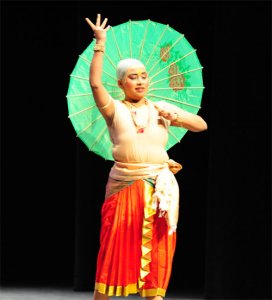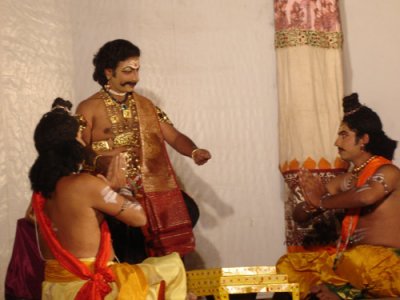
|   |

|   |
Vamana Avatar - B Venkat, Visakhapatnam e-mail: venkat.kuchipudi@yahoo.com January 5, 2011 A new Kuchipudi dance drama titled Vamana Avatar was presented by Gomathi, Vedantam Venkat and their team at Kalabharathi on the 26th of December 2011. The event was organized by Visakha Music and Dance Academy as part of a three day festival of dance. The program started right on the dot at 6.30pm. I was delayed and hurried to my seat. By that time itself Vedantam Venkata Nagachalapathy, as the mighty Bali Chakravarthy commanded total attention of the rasikas. The hall was filled to capacity. It was mesmerizing. First impression: By a mere flicker of his eyes Vedantam Venkat brings the royal asura king to life right in front of you. A Kuchipudi purist would explain the phenomenon to adherence to the details of shastras, to the effect of "drishti bedhas" and of course to his expressive eyes. I knew the ballet was right on track. The drama starts in Bali's court where Sukracharya urges Bali to dethrone Indra followed by a scene of apsaras dancing to Indra's joy. The song plays "Idhiye maa swarga seema…" (this is our region, swargam..). Lord Indra is in for a surprise, a timely message about Bali's conquest quickly ensures that he flees his swargam and Bali arrives. Now the apsaras dance to his command. Meanwhile Aditi makes a plea to Kasyapa to save her sons (Yemani Teluupudhu Praneswara - How to explain to you, my Lord). Kasyapa advises the distraught Aditi to pray to Lord Vishnu for help. The previous four avatars of Lord Vishnu were enacted here by dancers enhancing the effect of the dance drama. Devatas remind Lord Vishnu of his rescue in Gajendra Moksham and secure his assurance, and Vamana is born. After upanayana, Vamana proceeds to where Bali is performing yagnam. Here on, the story unfolds and Lord Vishnu fulfills his promise of restoring to Indra his Swarga Seema. How? Bali asks Vamana about his personal details and Vamana introduces thus "andharivadanu vundhunu andhariloni, kani vantari vadanu (I belong to all and live in all but alone). He proceeds to explain the purpose of his visit "sampada ledhu, sirini vidachiti” - I have no treasure, I gave up wealth (Goddess Lakshmi) - providing ample hint to Bali and Sukracharya about who he really is. The lyrics for this drama come out nice and timely and their content is easy to grasp and convey deep meaning.  Pic: Garry Berteig All eyes were transfixed on the character of Bali and on little Vamana as he seeks, responds, secures and thereafter occupies and spreads the space and universe with two steps. Vamana urges "Yedhi moodava adugu.." (Where is land/space for the third?). With Lord Vamana marking the third step on Bali's head, the ballet reaches conclusion. Mangalam follows soon thereafter. One thing about good script, story narration, sequence and choreography is that the tempo is built and interest of the audience is sustained. The dance and drama are mixed in right proportions so as to demonstrate their synergy besides allowing the artists to excel in both departments. The script provides a nice turn of events. It was Vamana who at first seeks for benevolence and Bali is so impressed with the 'boy' that he pleads with Vamana to choose something more than 'just three steps'! “Adugumu neekemi Illalo” - Seek what you want in this entire universe. The seeker becomes the sought! Such is the impact of the wondrous Vamana (Lord Vishnu) on his devotee, the writer seems to suggest.  Pic: Venkat
Vedantam Venkat impresses, proves beyond any doubt his mastery in all departments of Kuchipudi. As for abhinaya, his expressions of royalty, of karuna, and of bhakti flow effortlessly to bring rasa instantly. Gomathi played Vamana, transforming herself into a boy with all the mannerisms that come with it. She seems to prove the Kuchipudi concept of rupanurupam usually reserved for the role of Satyabhama but in this case, to the role of Vamana. Chinta Ravi Balakrishna (award winner of Yuva Puraskar this year) as Sukracharya was impressive. His pleads with Bali not to give in to Vamana's request for three steps of land yield no result. Bali counters, "Hari aina kanimmu, harudaina raneemmu.." (Be it Hari or be it Hara..) and concedes to Vamana. Fantastic expressions / abhinaya are found here. We also notice Vempati Surya Prasad and his striking resemblance to Vempati Ravi Shankar. The entire cast performed well and I noticed an impressive Seerisha demonstrating Lord Narasimha slaying the demon with wondrous effect. A few surprises are deliberately kept out of the review to preserve the "wow" factor. So arresting was the performance that the VMDA trustee quipped "it literally tied the esteemed guests including Sri Nedunuri Krishnamurthy and Police Commissioner to their seats." As to the dramatic effects, King Bali performs yagnam and ignites fire that spreads from the yaga hundam, and water flows out of Bali's kamandalam on to Vamana's hands. There was intelligent portrayal of how Sukracharya injures his eyes in his effort to stop Bali from acceding to the boy's request. Lokadharmi and Naatyadharmi, the two modes come to the fore. Here is the character list: Bali Chakravarthy- Vedantam Venkata Chalapathi, Vamana - Gomathi Boorada, Aditi - Kiran Vedantam, Kasyapa- Srinivas Yeleswarupu, Vishnu- Sarada Rama Krishna, Sukracharya- Chinta Balakrishna, Indra- Chinta Venkataramana, Surya - Vempati Surya Prasad, Apsaras- M Anusha Naidu, L Sowjanya, Sireesha, Rohini. The messengers were Tadepalli Sai Krishna, LV Ramana. Written very well by Tammina Paramathama, music is by GV Prabhakar, choreography and nattuvangam - Vedantam Venkat, playback- GV Prabhakar, DSV Sastri, Nitya Santhoshini, G Sruthi, violin- Dinakar, mridangam - P Sarma, flute - Ravikiran, Datta, veena- Srinivas, tabla- Jayakumar Acharya. |